Abstract
Arterial pressure increases during exercise and emotionally related stresses, and thus can theoretically be used as a sensor in a rate-adaptive system for determining the physiological need for an increase in rate. However, for long-term use in implantable devices, sensors have to be implanted on the right side of the heart. Thus the detection of the right atrial and ventricular pressure, and pulmonary arterial pressure are alternative approaches to detecting the consequences of exercise. Besides the use in rate-adaptive pacemakers, implantable sensors for the measurement of intracardiac hemodynamics may also be useful for improving the detection of ventricular tachycardias. The use of pacing therapy for hemodynamically stable ventricular tachycardia and defibrillation in the event of pacing induced acceleration into unstable ventricular tachycardia / fibrillation constitute recent tiered therapy for implantable antitachycardia pacers with cardioverter-defibrillator backup. Successful tiered therapy requires accurate hemodynamic detection capability and an intracardiac pressure sensor is a potentially very useful parameter.
Access this chapter
Tax calculation will be finalised at checkout
Purchases are for personal use only
Preview
Unable to display preview. Download preview PDF.
References
Cohen TJ (1984) A theoretical right atrial pressure feedback heart rate control system to restore physiologic control to the rate-limited heart. PACE 7: 671–677
Patterson SW, Piper H, Starling EH (1914) The regulation of the heart beat. J Physiol (Lond) 48: 465–513
Frank O (1959) On the dynamics of cardiac muscle. Am Heart J 58: 282–317
Wiggers CJ (1927) Studies on the cardiodynamic action of drugs: I. The Application of the optical methods of pressure registration in the study of cardiac stimulants and depressants; II. The mechanism of cardiac stimulation by epinephrine. J Pharmacol Exp Ther 30: 217
Wiggers CJ, Stimson B (1927) Studies on the cardiodynamic actions of drugs: III. The mechanism of cardiac stimulation by digitalis and g-strophanthin. J Pharmacol Exp Ther 30: 251
Bowditch HP (1871) Uber die Eigenthumlichkeiten der Reizarbeit, welche die Muskelfasern des Herzens zeigen. Ber Verh Königlich Sachsischen Ges Wissenschaften Leipzig 23: 852
Bennett TD (1985) Dynamic characteristic of alternative physiological pacing. PACE 8: 294 (abstr)
Anderson KM, Moore AA, Bennett TD (1986) Sensors in pacing. PACE 9: 954–959
Sutton R, Sharma A, Ingram A, Camm J, Lindemans F, Bennett T (1987) First derivative of right ventricular pressure as a sensor of an implantable rate-responsive VVI pacemaker. PACE 10: 1210 (abstr)
Sharma AD, Yee R, Bennett T, Erickson M, Beck R, Sutton R, Klein G (1987) The effects of ventricular pacing on right ventricular maximum positive dp/dt: implications for a rateresponsive pacing system based on this parameter. PACE 10: 1228 (abstr)
Sharma A, Bennett T, Sutton R, Ericson M, Yee R, Klein G (1988) Randomized single-blind assessment of rate-responsive pacing based upon maximum positive right ventricular dp/dt during treadmill exercise. PACE 11: 487 (abstr)
Lau CP, Butrous GS, Ward DE, Camm AJ (1989) Comparative assessment of exercise performance of six different rate adaptive right ventricular pacemakers. Am J Cardiol 63: 833–839
Ovsychcher I, Guetta V, Bondy C, Porath AVI (1992) First derivative of right ventricular pressure, dp/dt, as a sensor for a rate adaptive VVI pacemaker: initial experience. PACE 15: 211–218
Bennett T, Sharma A, Sutton R, Camm AJ, Erickson M, Beck R (1992). Development of a rate adaptive pacemaker based on the maximum rate-of-use of right vertricular pressure ( RV dp/dt max ). PACE 15: 219–234
Erickson MK, Bennett TD (1990) Right ventricular pressure for rate control: one year experience with dp/dt pacemaker in heart-blocked dogs. Rev Eur Technol Biomed 12: 33
Bennett TD, Sharma A (1990) Right ventricular pressure parameters for pacemaker automatic capture detection. Rev Eur Technol Biomed 12: 17
Lu B, Wood M, Ellenbogen KA, Valenta HL Jr (1990) Correlation of an invasive measure of right ventricular pressure and mean arterial pressure. Biomed Sei Instrum 26: 137–140
Cohen TJ, Lien LB (1990) A hemodynamically responsive antitachycardia system. Development and basis for design humans. Circulation 82: 394–406
Ellenbogen K, Lu B, Kapadis K, Wood M, Valenta H (1990) Usefulness of right ventricular pulse pressure as a potential sensor for hemodynamically unstable ventricular tachycardia. Am J Cardiol 65: 1105–1111
Laule M, Stangle K, Wirtzfeld A, Heinze R, Erhardt W, Schmalfeld B (1990) Intracardiac echo-Doppler-measurement: a new parameter for rate-responsive pacing? Rev Eur Technol Biomed 12: 33 (abstr)
Valenta HL, Wrigley RH, Ellenbogen KA, Lu B (1991) A new hemodynamic sensor for pacemakers and defibrillators. PACE 14: 659 (abstr)
Valenta H Jr, Nappholtz T, Maloney J, Simmons T, McElroy P (1986) Correlation of heart rate with an intravenous impedance, respiratory sensor. Biomed Sei Instrum 22: 7–12
McGoon MD, Shapland E, Salo R, Pederson B, Olive A (1989) The feasibility of utilizing the systolic pre-ejection interval as a determinant of pacing rate. J Am Coll Cardiol 14: 1753–1758
Theres H, Alt E, Zimmermann S, Heinz M, Oelker J, Huntley S (1991) Intracardiac impedance: an advanced concept for combination of multiple parameters for pacemaker rate control. PACE 14: 692 (abstr)
Alt E. (1991) Cardiac and pulmonary physiological analysis via intracardiac measurements with a single sensor. US Patent No. 5, 003, 976, 2. April 1991
Author information
Authors and Affiliations
Editor information
Editors and Affiliations
Rights and permissions
Copyright information
© 1993 Springer Verlag, Berlin Heidelberg
About this paper
Cite this paper
Lau, C.P. (1993). Intracardiac Pressure for Rate-Adaptive Pacing. In: Alt, E., Barold, S.S., Stangl, K. (eds) Rate Adaptive Cardiac Pacing. Springer, Berlin, Heidelberg. https://doi.org/10.1007/978-3-642-76649-7_9
Download citation
DOI: https://doi.org/10.1007/978-3-642-76649-7_9
Publisher Name: Springer, Berlin, Heidelberg
Print ISBN: 978-3-642-76651-0
Online ISBN: 978-3-642-76649-7
eBook Packages: Springer Book Archive

